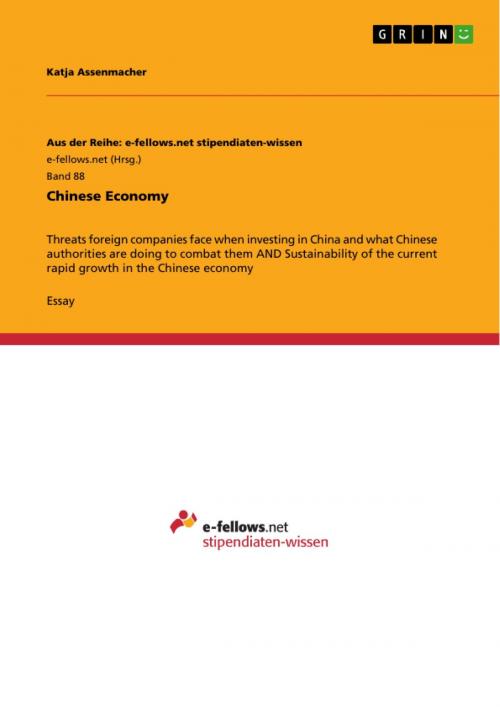Chinese Economy
Threats foreign companies face when investing in China and what Chinese authorities are doing to combat them AND Sustainability of the current rapid growth in the Chinese economy
Business & Finance, Economics, International| Author: | Katja Assenmacher | ISBN: | 9783640955251 |
| Publisher: | GRIN Verlag | Publication: | July 11, 2011 |
| Imprint: | GRIN Verlag | Language: | English |
| Author: | Katja Assenmacher |
| ISBN: | 9783640955251 |
| Publisher: | GRIN Verlag |
| Publication: | July 11, 2011 |
| Imprint: | GRIN Verlag |
| Language: | English |
Essay from the year 2010 in the subject Economics - International Economic Relations, grade: 1,3, Ashcroft International Business School Cambridge, language: English, abstract: The Assignmnet/Essay is divided in two questions: 1. Threats foreign companies face when investing in China and what Chinese authorities are doing to combat them In 1978 China introduced the Open Door Policy which was the first step to open up the Chinese market to international trade. The economic reforms during the 1980s caused China's growth rate to increase rapidly. The policy encouraged many Chinese firms to export their goods to Western companies and also Foreign Direct Investments (FDI) increased heavily. (Wei, 1995) China's entry to the World Trade Organisation (WTO) in 2001 the business opportunities for foreign companies in China grew. Western firm are keen to enter the Chinese market and to make use of these opportunities in the future. (Al-Khatib, Vollmers and Liu, 2007) 2. Sustainability of the current rapid growth in the Chinese economy China is undoubtedly known for its currently strong economic growth rate with has been on average 9% during the past years. This rate is not only high at Western European standards but also compared to other developing countries. The main reason for this development has been the effort China put in its integration into the global economy. (Zhang, Wu and Sanders, 2007) According to Yang and Lee (2002), China has a high potential for growth and it is becoming one of the biggest markets for international businesses. In order to rate this outlook, the factors in the Chinese economy that caused this development have to be assessed.
Essay from the year 2010 in the subject Economics - International Economic Relations, grade: 1,3, Ashcroft International Business School Cambridge, language: English, abstract: The Assignmnet/Essay is divided in two questions: 1. Threats foreign companies face when investing in China and what Chinese authorities are doing to combat them In 1978 China introduced the Open Door Policy which was the first step to open up the Chinese market to international trade. The economic reforms during the 1980s caused China's growth rate to increase rapidly. The policy encouraged many Chinese firms to export their goods to Western companies and also Foreign Direct Investments (FDI) increased heavily. (Wei, 1995) China's entry to the World Trade Organisation (WTO) in 2001 the business opportunities for foreign companies in China grew. Western firm are keen to enter the Chinese market and to make use of these opportunities in the future. (Al-Khatib, Vollmers and Liu, 2007) 2. Sustainability of the current rapid growth in the Chinese economy China is undoubtedly known for its currently strong economic growth rate with has been on average 9% during the past years. This rate is not only high at Western European standards but also compared to other developing countries. The main reason for this development has been the effort China put in its integration into the global economy. (Zhang, Wu and Sanders, 2007) According to Yang and Lee (2002), China has a high potential for growth and it is becoming one of the biggest markets for international businesses. In order to rate this outlook, the factors in the Chinese economy that caused this development have to be assessed.















